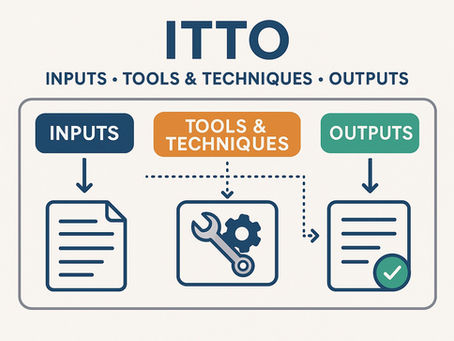top of page
Search


Change Management Phrases: The Power of Words in Change
Change management phrases help organisations communicate transformation clearly, consistently, and effectively. The right language shapes perception, guides behaviour, and strengthens trust across large enterprises.

Michelle M
4 days ago6 min read


Finance Coordinator: Key Responsibilities and Skills
The Finance Coordinator plays a key role in large organizations by supporting financial processes, managing documentation, coordinating stakeholders, and ensuring compliance.

Michelle M
Nov 164 min read


Agile Outsourcing: The Smart Way to Scale Enterprise Agility
Agile Outsourcing enables large enterprises to extend their Agile capabilities beyond internal teams, building partnerships based on collaboration, transparency, and shared value. It replaces rigid contracts with dynamic collaboration, ensuring that outsourced work contributes directly to business outcomes.

Michelle M
Nov 146 min read


Is the PMP Exam Hard: How to Prepare and Pass with Confidence
So, is the PMP exam hard? Yes but it is also one of the most rewarding professional challenges in a corporate career. The effort required to earn the PMP credential translates directly into improved leadership, structured decision-making, and strategic value creation within any enterprise.

Michelle M
Nov 97 min read


Agile Map: Guiding An Organization Through Its Agile Journey
An Agile Map is not just a diagram it is the backbone of enterprise agility. It provides visibility, alignment, and strategy execution clarity across complex global organizations.
By mapping teams, portfolios, and governance structures, enterprises transform ambiguity into insight and chaos into coordination.

Michelle M
Nov 76 min read


ITIL vs Agile: Understanding the Balance Between Control and Flexibility
The debate between ITIL vs Agile is not about choosing one over the other it is about integrating both to achieve balance. ITIL ensures governance, compliance, and service reliability, while Agile brings flexibility, innovation, and customer focus.

Michelle M
Nov 66 min read


Agile Office Space Design: Building Workplaces That Inspire Innovation
Agile office space design redefines how large enterprises think about work environments. It transforms offices into dynamic ecosystems that promote collaboration, creativity, and flexibility. When aligned with Agile culture and governance, the workspace becomes a strategic driver of business performance and innovation.

Michelle M
Nov 55 min read


Agile Methodology Books That Shape Business Agility
Agile methodology books are essential resources for large organizations seeking to build scalable, sustainable, and human-centered agility. They provide the intellectual foundation for every transformation journey, guiding executives, PMOs, coaches, and teams toward better collaboration and value delivery

Michelle M
Nov 47 min read


Agile Nearshore: Enhancing Speed and Quality at Scale
Agile nearshore delivery has become a cornerstone of enterprise agility. It combines the flexibility of local collaboration with the efficiency of global resourcing. By embedding nearshore partners within their Agile frameworks, large organizations can accelerate delivery, maintain quality, and scale sustainably.

Michelle M
Nov 35 min read


Security and Project Management: Building Corporate Resilience
Security and project management are inseparable in today’s corporate landscape. Every initiative, whether technological or operational, must consider the security implications of its actions.

Michelle M
Nov 26 min read


Start to Finish Project Management: A Corporate Lifecycle Approach
Start to finish project management represents the complete lifecycle of corporate project governance. It integrates strategy, execution, and evaluation into a unified process that strengthens accountability and performance.

Michelle M
Nov 26 min read


Project Management Schedule Levels: Integrating Planning
Understanding and applying Project Management Schedule Levels allows corporations to manage time, risk, and resources with precision. This structured hierarchy ensures that strategic objectives translate seamlessly into operational execution.

Michelle M
Nov 26 min read


ITTO Project Management: How Inputs and Outputs Drive Project Success
ITTO Project Management represents the backbone of structured, accountable, and transparent project execution in corporate environments. It connects governance with delivery, ensuring that every input, action, and output aligns with organizational goals.

Michelle M
Nov 17 min read


Government Project Management: The Future of Public Sector Projects
Government Project Management is not merely about executing projectsit is about ensuring accountability, efficiency, and public value. It combines the precision of corporate project management with the ethical and social responsibility of public service.

Michelle M
Nov 16 min read


Project Manager Attire: How Appearance Impacts Leadership
Project manager attire is more than a matter of style. It represents professionalism, confidence, and respect for the people and projects you lead. The right attire enhances credibility, communicates readiness, and influences how others perceive your competence and leadership.

Michelle M
Oct 287 min read


Daptiv Project Management: The Engine of Modern PMOs
Daptiv Project Management is far more than a software tool it is a strategic framework that enables corporations to align projects with business priorities, optimize resource use, and strengthen governance.

Michelle M
Oct 286 min read


Project Management Knowledge Areas: Best Practices for Success
Project management knowledge areas provide the foundation for managing projects effectively. From integration and scope to risk, procurement, and stakeholder management, each area represents critical skills and processes.

Michelle M
Oct 266 min read


Statement of Work vs Scope of Work: Differences Explained
Understanding Statement of Work vs Scope of Work is essential for anyone involved in project management. Both are vital tools for defining project goals, setting expectations, and ensuring successful outcomes.
The Statement of Work provides the “big picture,” detailing the project’s objectives, deliverables, and contractual framework. The Scope of Work focuses on the operational details, explaining how the work will be completed and who will do it.

Michelle M
Oct 196 min read


Azure DevOps vs Jira: Choosing the Right Tool for DevOps Success
The debate of Azure DevOps vs Jira is not about which tool is better, but which one fits your organization’s workflow best. Azure DevOps excels as an all-in-one solution for teams seeking full lifecycle management, while Jira remains the gold standard for agile project management with an extensive integration ecosystem.

Michelle M
Oct 198 min read


Retrospective vs Retroactive: A Complete Guide for Project Managers
Understanding the difference between retrospective and retroactive can dramatically improve how project managers evaluate performance, address mistakes, and guide teams toward better outcomes in the future. In this comprehensive guide, we will explore both terms in detail, outline their applications, and discuss best practices for incorporating them effectively into project management.

Michelle M
Oct 187 min read
bottom of page
